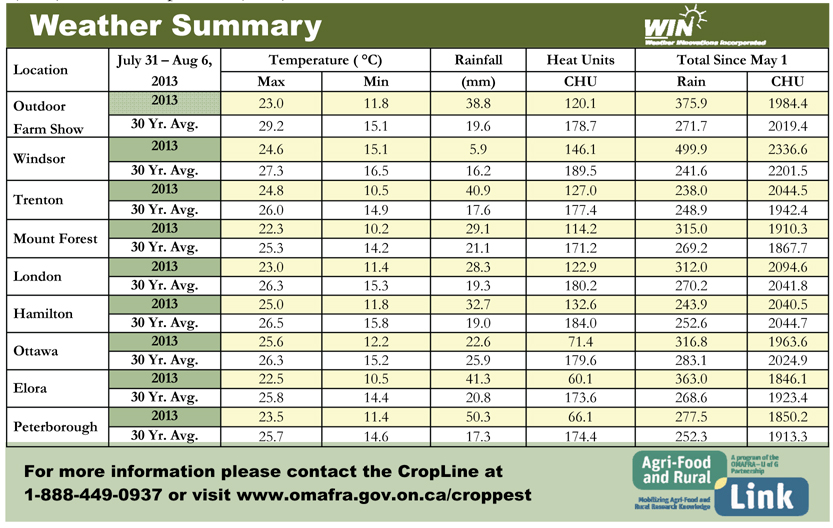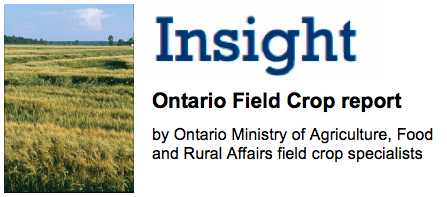Soybeans: Horst Bohner
Soybean plant growth and flowering has been moderate over the last two weeks due to cooler temperatures. Many varieties are at the R4 (full pod) stage of development. Spider mites have been a problem in a few areas where conditions were dry. Stippling causes yellowing, curling and bronzing of leaves, is evident along field edges and pockets within fields. Damage is most severe under hot dry conditions. There can be up to seven generations in a given year but a good rain along with cooler weather will reduce numbers in fields naturally. Dimethoate is the only registered product that will control spider mites in soybeans. Fields should be sprayed if they are above threshold (one damaged leaf per plant) up to the R6 growth stage. (seeds within one pod on the top four nodes fills the pod cavity) Soybean aphid populations are building slowly and continued monitoring will be necessary until the R6 growth stage. Considerable acreage has been sprayed in Eastern Ontario. Most regions in western Ontario have low aphid numbers or no aphid pressure. Soybean cyst nematode (SCN) and root rot symptoms have increased over the past week. White mould, downy mildew and frog-eye leaf spot are present but have not progressed to significant levels to date. Growers should continue to scout for these diseases over the next few weeks. If SCN is present in the field consider taking soil samples to monitor populations.
Forages/Pastures: Joel Bagg/Jack Kyle
Forages: Summer seeding alfalfa and alfalfa-grass mixtures can be a good way to establish new fields so that full season yields can be harvested next year. It is typically done after winter wheat or spring cereals are harvested. Alfalfa needs at least 6 weeks of growth after germination to develop a crown before killing frost to survive the winter. Recommended summer seeding dates are:
• > 2900 CHU areas - August 10th - 20th
• 2500 - 2900 CHU areas - August 1st - 10th
• < 2500 CHU areas- July 20th - 30th.
Lack of moisture for timely germination and growth can be a risk. If soil conditions are extremely dry and no rain is in the forecast, plans for summer seeding should be abandoned. Conserving soil moisture is critical, so use as little tillage as possible to create a fine, firm seedbed, drill the seed rather than broadcasting it, and follow with a press wheel or packer to ensure good seed-to-soil contact. Competition from volunteer wheat can be a serious problem. This is especially true if a lot of light grain went through the combine, such as in fusarium infection situations. One approach to reduce volunteer wheat is to do some light tillage to encourage the grain to germinate. A burndown with glyphosate or a second cultivation 10 days later will destroy much of this grain. Do not use companion crops with summer seedings, as they compete for available soil moisture and reduce stand establishment. Seeding alfalfa after alfalfa is not recommended because of autotoxicity and disease. http://fieldcropnews.com/?p=3316
Seeding oats in early-August following wheat for an early-October harvest can be a useful doublecrop, low-cost option for producing extra forage. Oats can make excellent feed when harvested at the correct stage of maturity and made into “oatlage” or baleage. Peas can be added where higher forage quality is required.The challenges can sometimes be lack of adequate moisture in August for germination and growth, and having dry enough weather in October for adequate wilting. http://fieldcropnews.com/?p=4264
Pastures: Early August rainfall has been positive for pasture growth. Rotationally grazed pastures continue to have quality forage while continuously grazed pastures have become a mix of mature and over grazed areas. A rotational system that provides the pasture plants with adequate rest and recovery will provide quality pasture through August and in to late fall.
Early August is the ideal time to plant annual crops for late fall grazing - oats are the easiest and most versatile. Brassicas (stubble turnips) planted in August will provide late fall grazing. Cereal rye planted in early September will provide grazing in the early spring of next year. Keep in mind that every day of grazing is half the feed cost of using stored feed.
Soil Management: Adam Hayes
Now is an excellent time to plant a cover crop following a cereal crop. Cover crops can provide a number of benefits from improving the soil and cycling nutrients to minimizing weeds and suppressing diseases. Before you plant consider what it is you want the cover crop to do. Seed may be sourced from a local seed supplier, a seed company or the bin. Before planting consider the fertility needs of the cover crop. Some cover crops such as spring cereals and radish require nitrogen to achieve good growth. Also consider timing of planting. The more time the cover crop has to grow the more benefit it will provide. If the cover crop is not planted until into September then a winter cereal may be a better choice as other cover crops will not provide much growth planted that late. Drilling or planting are the best options for establishment as it gets the seed in contact with moisture for a quicker start. And finally consider termination of the cover crop – how will the cover crop be controlled at the end of the season? A couple of options to consider are oats and oilseed radish (OSR) or cover crop radish (CCR) or oats, OSR or CCR and a clover such as crimson clover.




